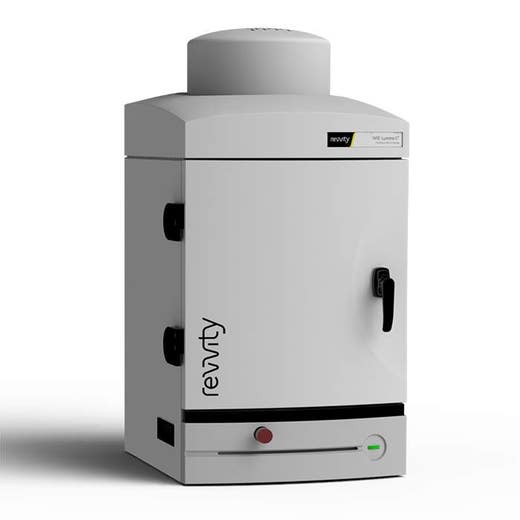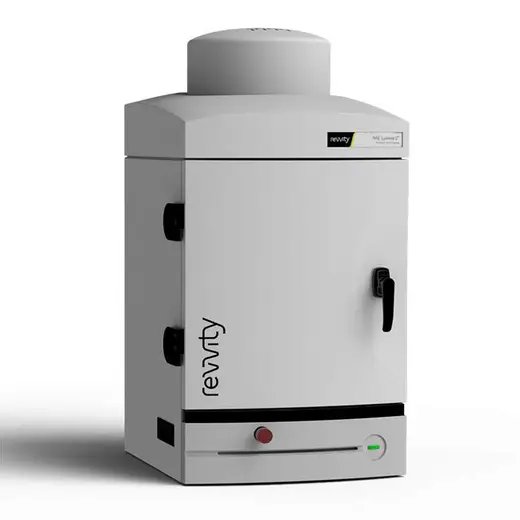
IVIS Lumina LT In Vivo Imaging System


IVIS Lumina LT In Vivo Imaging System


IVIS Lumina Series III benchtop 2D optical imaging system
IVIS Lumina LT In Vivo Imaging System


The IVIS® Lumina LT Series III pre-clinical in vivo imaging system offers the industries most sensitive benchtop platform at an entry level price.
Product Variant
Imaging Modality: 2D Bioluminescence, 2D Fluorescence
Part #:
CLS136331
For research use only. Not for use in diagnostic procedures.
Supporting products you might need
Product information
Overview
The standard instrument is equipped with full bioluminscence, radioisoptic (Cerenkov) imaging capabilities for 2D imaging and standard fluorescence. For more sophisticated fluorescent models, the Lumina LT can be upgraded to a full Lumina Series III.
Features/Benefits:
- Bioluminescence
- Fluorescence
- Radioisotopic Cerenkov Imaging
- Compute Pure Spectrum Spectral Unmixing
- DyCE Imaging (Optional Upgrade)
- Extended NIR Range 150W Tungsten EKE
- Absolute Calibration to NIST® Standards
- Complimentary Living Image™ software licenses are provided with the IVIS systems and upon request.
Specifications
| Dimensions | 48.0 cm (W) x 104.0 cm (H) |
|---|
| Brand |
IVIS
|
|---|---|
| Imaging Modality |
2D Bioluminescence
2D Fluorescence
|
| Unit Size |
1 Unit
|
References
- Wang et al (2021). LncRNA SPOCD1-AS from ovarian cancer extracellular vesicles remodels mesothelial cells to promote peritoneal metastasis via interacting with G3BP1. J Exp & Clin Res. 40(101). https://doi.org/10.1186/s13046-021-01899-6
- Zhong et al (2021). Calcium phosphate engineered photosynthetic microalgae to combat hypoxic-tumor by in-situ modulating hypoxia and cascade radio-phototherapy. Thernostics. 11(8): 3580–3594. https://dx.doi.org/10.7150%2Fthno.55441
- Li et al (2020). High selective distinguishable detection GSH and H2S based on steric configuration of molecular in Vivo. Dyes & Pigments. 172;107826. https://doi.org/10.1016/j.dyepig.2019.107826
- Korolev et al (2020). Fluorescent Nanoagents for Biomedical Applications. Fluorescence Methods for Investigation of Living Cells and Microorganisms. https://doi.org/10.5772/intechopen.92904
- Zhai et al (2020). An ATF24 peptide-functionalized β-elemene-nanostructured lipid carrier combined with cisplatin for bladder cancer treatment. Cancer Biol & Med. 17(3): 676–692. https://dx.doi.org/10.20892%2Fj.issn.2095-3941.2020.0454
- Natoni et al (2020). Sialyltransferase inhibition leads to inhibition of tumor cell interactions with E-selectin, VCAM1, and MADCAM1, and improves survival in a human multiple myeloma mouse model. Haematologia. 105(2): 457–467. https://dx.doi.org/10.3324%2Fhaematol.2018.212266
- Costa et al (2019). Murine infection with bioluminescent Leishmania infantum axenic amastigotes applied to drug discovery. Sci Reports. 9: 18989. https://doi.org/10.1038/s41598-019-55474-3
- Ramachandran et al (2019). Non-invasive in vivo imaging of fluorescence-labeled bacterial distributions in aquatic species. Internat'l J Vet Sci Med. 5(2). https://doi.org/10.1016/j.ijvsm.2017.09.003
- Song et al (2019). Overcoming hypoxia-induced chemoresistance to cisplatin through tumor oxygenation monitored by optical imaging. Nanothernostics. 3(2): 223–235. https://dx.doi.org/10.7150%2Fntno.35935
- Lorscheider et al (2019). Dexamethasone palmitate nanoparticles: An efficient treatment for rheumatoid arthritis. J Controlled Rel. 296:179-189. https://doi.org/10.1016/j.jconrel.2019.01.015
- Lazzari et al (2018). Multicellular spheroid based on a triple co-culture: A novel 3D model to mimic pancreatic tumor complexity. Acta Biomaterials. 78: 296-307. https://doi.org/10.1016/j.actbio.2018.08.008
- Cayre et al (2017). In Vivo FRET Imaging to Predict the Risk Associated with Hepatic Accumulation of Squalene‐Based Prodrug Nanoparticles. Adv. Healthcare Mat. https://doi.org/10.1002/adhm.201700830
Resources
Are you looking for resources, click on the resource type to explore further.
Technical Note
Working with Image math to subtract background from images without performing spectral unmixing


How can we help you?
We are here to answer your questions.






























